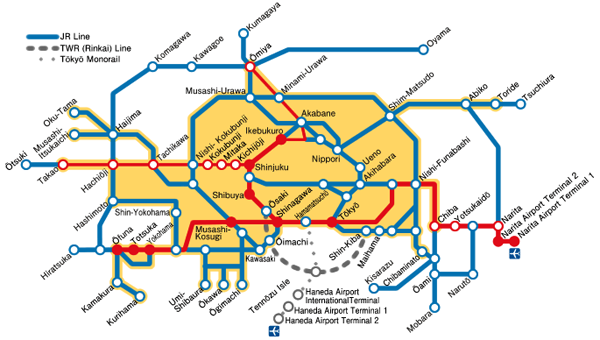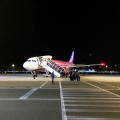In Singapore, we are used to traveling via many different modes – Taxis, cars, buses, trains…
In Japan, I recommend:
- Taxis: Only if you are very rich. Or incredibly lazy. Or dying.
Fares start from 660yen (SGD 9) for the first 2km, and jumps by about 100yen (SGD 1.35) for every subsequent 500m - Cars: In ulu places like Shizuoka or Okinawa where public transport is greatly lacking.
As cheap as 5,250yen (SGD 70) for 6 hours (from Toyota Rent-a-car) - Buses: Only if you know what you are doing.
Unlike Singapore, buses here can be as infrequent as coming once per hour. Plus, the signs are mostly in Japanese, so that’s an additional hurdle, which brings us to… - Trains: The most convenient method of traveling in big cities, and the focus of this post.
Train fares in Japan are not cheap – in fact, very expensive when compared to Singapore’s. But the trains here run like clockwork; accurate to the very minute. It doesn’t matter if it’s a shinkansen (bullet train) or local train. If it says it’ll leave at 12.15, it will leave at 12.15.
Of course, there are exceptions, although in probably a different meaning than SMRT’s. When there’s bad weather like snow, typhoon, earthquakes, or the unfortunately rather common reason… when people fall on to train tracks.
If you see “人身事故” (jin shin ji ko, accident resulting in injury or death) running across the train boards at stations, it means someone somewhere has fallen on to the tracks, whether accidental or intentional.
I see the 人身事故 notice quite often, but have only been affected by it once, where my train was delayed by more than an hour, and I had to stand in the crushing crowd with my heavy purchases from IKEA. But I digress. Back to train travel!
Super essential tool: Hyperdia
You cannot do without this if you are going free-and-easy. Tells you everything you need to know from the train line to board, duration of travel to train fare. USE IT.
GOOD TO KNOW
There are many train companies in Japan, from the major Japan Railways Group (JR), subways (Tokyo Metro, etc), private railway companies (Keio, Tobu, etc). This will be important later.
There are many, many passes available for travel in Japan. I’ll just touch on the more general and common ones in this post.
Traveling all around Japan
If you’re planning to travel all over Japan, and maybe spending more time on the train than you do on the ground, then you have would have been horrified by the numbers quoted by Hyperdia. Tokyo->Osaka would cost a good 14,000yen (SGD 190).
What you need: Japan Rail Pass
Travel on almost all JR trains for a flat rate! But remember, this is only valid on JR trains. Not subways, and not any other company’s train.
Traveling in East Japan
(Tokyo, Nagano, Niigata, Akita, and dare I say it… Fukushima, Sendai)
Ideal if you’re planning to visit these places:
Explore east Japan without breaking the bank. Also includes travel to both aiports in Tokyo: Narita and Haneda.
What you need: JR East Pass (or the JR East Pass Special, available for a limited period)
Traveling in Kanto
(Tokyo, Mount Fuji, Nikko, Shizuoka, Karuizawa, etc)
If East Japan is too big/far to explore, then maybe this will be more suitable.
What you need: JR Kanto Area Pass
Traveling in Tokyo
If you’re staying within Tokyo, then one of these passes will be good.
JR trains only: Tokyo Metropolitan District Pass (730yen)
JR + Tokyo Metro subway + Toei subway trains: Tokyo Tour Ticket (1,580yen)
Traveling from/to Narita Airport
Assuming you did not buy a pass that lets you travel from/to Narita Airport, then this ticket is a very good deal!
Non-Japanese passport holders get about 50% off the regular ticket price!
What you need: N’EX TOKYO Direct Ticket
Traveling without a pass
Suppose none of these passes are suitable for your trip. You can consider buying a Suica card (a card with stored value) so that you won’t have to bother with the hassle of figuring how much each trip costs and buy the ticket before each travel.
What you need: Suica card
TIP!
Suica = Singapore’s EZ-link card.
It is something like a prepaid card that lets you top-up and pay for your train fares, purchases from shops, etc.TIP 2
You can also use the Suica on private railway lines and subways in Tokyo! Basically… on all trains in Tokyo!
For even more rail passes of the whole of Japan, this website is very useful.
Have fun train traveling! I LOVE traveling on trains! Sometimes I can take 2 hours to sleep in bed, but put me on a train, I’ll be asleep in a snap.








Hi there! I just wanna say I really really love your blog. I’m going to Japan in two months and this blog has been very helpful and informative. I also saw your post on RotiBoy in Seoul and in fact, I’ve been a regular patron of it too since moving to Korea last year. Glad to know I’m not the only Singaporean who’s crazy (about) and missing RotiBoy a lot!!! hahah ^^
Hello Mumul! Thank you for taking the time to leave such a sweet comment! It really makes my day when I know what I wrote helped others :) Aww, you get to eat Rotiboy often! So jealous! Is there more than one branch in Seoul?
Pingback: Train travel in Japan - 2nd Edition • tripleRIN
Pingback: Budget Accommodation in Tokyo • tripleRIN
Thanks for describing the travel way of Japan.